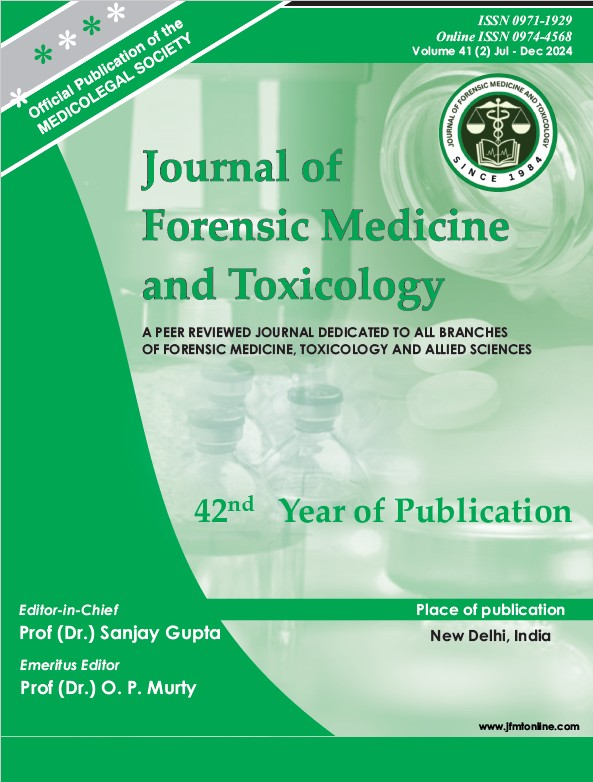Haemorrhage in Middle Ear and Mastoid Air Cells (Temporal bone) in Drowning cases- an Autopsy based Cross-sectional study
DOI:
https://doi.org/10.48165/jfmt.2025.42.3.9Keywords:
Asphyxia, Autopsy, Drowning, Hemorrhage, Mastoid air cell, Middle earAbstract
Drowning is a form of asphyxia due to aspiration of fluid into air-passages, caused by submersion in water or other fluid. Complete submersion is not necessary, for submer sion of the nose and mouth alone for a sufficient period can cause death from drowning.1 Hemorrhage in the middle ear (barotrauma) is a recognized result of drowning. The middle ear is a narrow air-filled space in the petrous part of the temporal bone between the external ear and the as seen in 65% of cases, out of which it was bilateral in 27% of cases, only right side in 22% of cases, and only left side in 16% of cases. Hemorrhage in mastoid air cells was seen in 57% of cases, out of which it was bilateral in 14% of cases, only the right side in 22% of cases, and only the left side in 21% of cases. Middle ear hemorrhage in drowning cases aids forensic pathologists in determining cause of death, distinguishing drowning from other causes and providing insights into water asphyxiation mechanisms.
Downloads
References
1. Reddy KSN. The Essentials of Forensic Medicine & Toxicology. 35th ed. New Delhi: Jaypee Brothers; p. 282.
2. Chaurasia BD. Human Anatomy: Regional and Applied. Vol. 3: Head, Neck, and Brain. 9th ed. New Delhi: CBC Publishers; 2023. p. 310–311.
3. Robbins RD, Sekhar HK, Siveris V. Temporal bone histopathologic findings in drowning victims. Arch Otolaryngol Head Neck Surg. 1988;114(9):1020–1023.
4. Niles NR. Haemorrhage in the middle ear and mastoid in drowning. Am J Clin Pathol. 1963;40:281–283.
5. Saphir O. Autopsy Diagnosis and Technic. 4th ed. New York: Hoeber-Harper; 1961.
6. Gresham GA, Turner AF. Post Mortem Procedure: An Illustrated Textbook. London: Wolfe Medical Publisher; 1979. p. 79.
7. Kumar P, Tandon A, et al. A study on epidemiological profile of drowning victims at a tertiary care centre. Int J Med Toxicol Legal Med. 2021;23(1):55–58.
8. Behera C, Rautji R, Lalwani S. Study of drowning cases in South Delhi. J Indian Acad Forensic Med. 2018;40(3):242–245.
9. Reddy KSN, Sharma M. Profile of drowning deaths in Andhra Pradesh: An autopsy based study. Indian J Forensic Med Pathol. 2016;9(1):22–26.
10. Pathak A, Kanchan T, Krishan K. Drowning deaths: an analysis from coastal Karnataka. Egypt J Forensic Sci. 2019;9(1):17.
11. Mitra B, Datta P, et al. Pattern of drowning in Eastern India: An autopsy-based study. Med Leg J. 2020;88(2):90–95.
12. Panchal A, Jaiswal A, et al. Autopsy findings in drowning cases. Int J Forensic Med Invest. 2018;4(2):12–15.
13. Pathak A, Pradhan A. Evaluation of classical signs in drowning autopsies: A prospective study. J Forensic MedToxicol. 2020;37(1):55–59.
14. Ambade V, Godbole HV, et al. Diagnostic value of drowning signs in autopsy: A comparative study. Egypt J Forensic Sci. 2013;3(2):53–56.
15. Saukko P, Knight B. Knight’s Forensic Pathology. 4th ed. CRC Press; 2015.
16. Garg M, Kaushik S, Singh V. Evaluation of autopsy findings in drowning deaths: A regional perspective. J Indian Acad Forensic Med. 2022;44(3):290–294.
17. Tripude BH, et al. Pattern of lung changes in drowning deaths: A prospective study. Medico-Legal Update. 2015;15(2):79–82.
18. Chidanand C, Satish KV. Study of incidence of middle ear hemorrhage in drowning. J Evid Based Med Healthcare. 2015;2(6):621–628.
19. Dhakar RK, Baraw R, Tomar MS, Singh S. Unveiling the significance and incidence of middle ear hemorrhage in drowning cases: An insight from autopsy observations conducted in a tertiary centre of Central India. Int J Pharm Clin Res. 2024 Mar 30;16(3):924–927.




